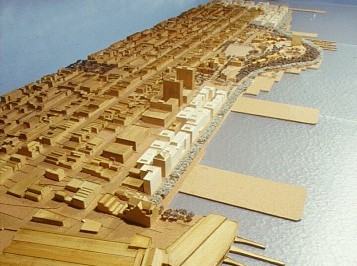After 32 years, FBW’s proposed plan along the Hudson River is closer to being realized

FBW | September 14, 2022
For most of the 1900s, maritime industries dominated Hoboken’s Hudson River waterfront. The transformation of this waterfront began some thirty years ago as new commercial and residential projects were built along with a continuous, public waterfront park.
The first park, Sinatra Park, was built in 1994. Then came Pier A Park and the promenade at the South Waterfront. By 1998, the construction of the 1600-unit Shipyard Project began. In 2001, the City approved the Maxwell Place Project with a city-owned waterfront park. Castle Point Park followed and then, in 2003, Pier C Park.
These waterfront parks added nearly 18 acres of parkland to this mile-square town that for many years had suffered from one of the lowest per capita public open space ratios in New Jersey. This was the first major addition of parkland for Hoboken since its first small parks — Church Square Park, Stevens Park (originally Hudson Square), Elysian Park and Columbus Park — totalling about 11 acres were built some 100 years earlier.
In the next several years, there will be two significant additions, completing several of the final gaps in Hoboken’s waterfront park, one at the Weehawken Cove (2.5 acres) and the other at Union Dry Dock (3 acres). The construction of the Sinatra Drive Project beginning next year will be a dramatic improvement to the central waterfront that will tie together many of these parks from Fourth to Eleventh Streets with a protected bicycle pathway, widened sidewalks and hopefully a continuous row of street trees.
The total acres, however, are less important than the goal of fully connecting the park for the entire length of Hoboken’s riverfront from the Hoboken Terminal up to the Weehawken Cove. This was the vision set forth by the Fund for a Better Waterfront (FBW) in 1990 with its Plan for the Hoboken Waterfront. FBW’s plan and continued advocacy became the driving force in shaping the development of Hoboken’s riverfront and establishing a clear delineation between the park at the water’s edge and the upland blocks for private development. The linear nature of the park encourages walking, running and cycling its length. Hoboken’s waterfront park also connects to the Waterfront Walkway in Jersey City to the south and in Weehawken to the north.
The other eight municipalities facing New Jersey’s Hudson River waterfront failed to come up with such a plan and instead settled on the minimum state requirement for the 30-foot Hudson River Waterfront Walkway. In these municipalities, private developers drove the planning process and built as close to the water’s edge as possible. The failure to extend the traditional public street grids to the waterfront made the water’s edge more difficult to access and diminished its public value.
Hoboken has come full circle. In the late 1700s, after Col. John Stevens acquired the land that would become Hoboken, he established Elysian Fields, River Walk (complete with a beer garden) and other features to attract people to Hoboken and its fully accessible waterfront. Col. Stevens had hundreds of acres of land that he sought to sell and he used a public waterfront as one of his key marketing strategies.
By the late 1800s and throughout the 20th century, however, Hoboken became a port city and its waterfront was dominated by ocean liners, ship builders and other maritime industries. The waterfront then became off limits to the public.
In 1990, there was an opportunity for a new vision for what the waterfront could be. FBW took advantage of that once in a century opportunity to transform the water’s edge into a linear public park. Today, Hoboken’s waterfront park is central to the life and vitality of Hoboken.
Related Links
Making the “green circuit” greener along Hoboken’s waterfront
Construction of a long-awaited waterfront park at the Weehawken Cove will begin next spring
The Hudson River waterfront and the planning process: public or private?
After a contentious, multi-year battle, City will acquire Union Dry Dock
Maxwell Place Park, former home to the Maxwell House Coffee Plant
FBW’s 30-year history
Plan for the Hoboken Waterfront

